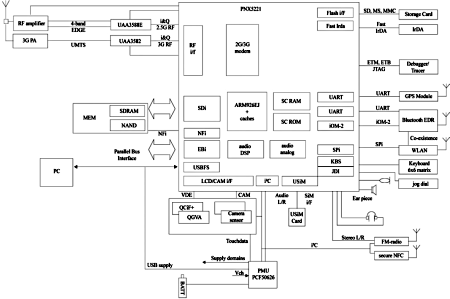Linux stack vendor announces first hardware partner
Feb 6, 2008 — by Eric Brown — from the LinuxDevices Archive — views A week after announcing its first Linux-based mobile phone stack, Azingo (formerly Celunite) has announced its first hardware partner. The LiMo-compliant Azingo Mobile stack will be ported to NXP's Nexperia Cellular Solution 7210 reference design, which uses a… single-core architecture and targets low-cost 3G handsets.
A week after announcing its first Linux-based mobile phone stack, Azingo (formerly Celunite) has announced its first hardware partner. The LiMo-compliant Azingo Mobile stack will be ported to NXP's Nexperia Cellular Solution 7210 reference design, which uses a… single-core architecture and targets low-cost 3G handsets.
Azingo launched Azingo Mobile just last week. The stack is positioned as a comprehensive software/services offering for mid-tier feature-phones compliant with LiMo (Linux Mobile Foundation) requirements.
Azingo says that when deployed on NXP's Nexperia 7210 design, its mobile stack will address the mid-tier market for 3G and 3.5G Linux-based mobile phones that run dual-mode EDGE/UMTS and EDGE/HSPA multimedia platforms. The company hopes to announce additional hardware partners in the days and weeks ahead, it said.
 The “Purple Magic” also uses NXP's 7210 design (Click for details) |
Azingo Mobile is not the first Linux stack announced as supporting the NXP 7210 phone hardware reference design. Only last week Philips spin-off NXP announced it was collaborating with French mobile Linux phone stack firm Purple Labs on a hardware/software reference design aimed at sub-$100 3G phones for emerging markets.
The Nexperia Cellular System Solution 7210 reference design was unveiled a year ago at the Mobile World Congress Barcelona conference. The design is built around the PNX5221, a highly integrated SoC (system-on-chip) for GSM/GPRS/EDGE/UMTS mobile handsets. Powered by a single ARM926EJ processor and a pair of 16-bit DSPs that handle image and signal processing, the SoC supports Dual Transfer Mode (DTM), supporting both 2.5 or 3G networks.
NXP was able to use a single core instead of more expensive dual processors thanks to the 7210's use of the VirtualLogix VLX-MH virtualization stack for handsets. VLX-MH enables the 7210's single ARM9 core to simultaneously run Linux along with a real-time OS (RTOS) that controls the modem and voice signal processing.

Nexperia 7210 block diagram
(Click to enlarge)
Stated Mahesh Veerina, Azingo CEO, “There's a growing demand from large operators to deliver even higher performing 3G phones in the mid-tier price range. The Azingo/NXP joint solution is an attractive platform for this market, given its price/performance ratio. Leveraging LiMo's ecosystem is an added benefit.”
Availability
At presstime, Azingo did not have information on the availability of the upcoming Nexperia-based phone. Nor will it have a prototype to show at the GSM Mobile World show next week in Barcelona, a spokesperson said.
This article was originally published on LinuxDevices.com and has been donated to the open source community by QuinStreet Inc. Please visit LinuxToday.com for up-to-date news and articles about Linux and open source.